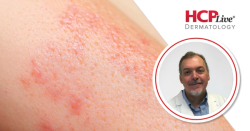
OR WAIT null SECS
Bimekizumab Shows Long-Term Psoriasis Skin Clearance in 4-Year Phase 3 Data
More than 60% of patients with psoriasis achieved PASI 100 at week 16 with bimekizumab and maintained skin clearance up to 4 Years.
A pooled analysis of 4 phase 3 trials showed how many participants on bimekizumab achieved complete skin clearance, indicated by a Psoriasis Area and Severity Index (PASI) 100, by week 16.
This analysis, led by Mark Lebwohl, MD, from the department of dermatology at Icahn School of Medicine at Mount Sinai, was presented at the Society of Dermatology Physician Assistant (SDPA) 2025 Annual Summer Meeting in Washington, DC, from June 25 – 29th. Lebwohl and colleagues sought to assess whether patients treated with bimekizumab achieved PASI 100 after 16 weeks and maintained efficacy thresholds at every or most visits over 4 years. Bimekizumab, a monoclonal IgG1 antibody that selectively inhibits interleukin (IL)-17-F and IL-17A, is approved by the US Food and Drug Administration (FDA) for the treatment of moderate to severe plaque psoriasis.
Biologics help clear psoriasis, but many patients lose disease control over time. Thus, it is important to evaluate psoriasis treatments in the long term. The National Psoriasis Foundation has reported that the most preferred time for evaluating patient response after starting a new treatment is 3 months.
In this study, the team pooled phase 3 data from BE SURE, BE VIVID, BE READY, and the open-label extension BE BRIGHT. Participants received bimekizumab 320 mg every 4 weeks until week 16 and then every 4 or 8 weeks until week 48.
“In BE SURE, we saw significantly higher skin clearance rates with bimekizumab compared with one of the most commonly used biologic treatments in psoriasis,” said investigator Richard Warren, from Salford Royal NHS Foundation Trust and The University of Manchester, United Kingdom, in a 2020 statement. “The study results also demonstrated the potential benefits of switching patients who are being treated with adalimumab to bimekizumab.”
During BE SURE, 86.2% of patients treated with bimekizumab achieved almost clear skin (PASI 90) compared with 47.2% of patients treated with adalimumab at week 16 (P < .001).
In this recent pooled analysis, investigators included data on proportions of patients achieving PSAI 100 at week 16 who maintained bimekizumab ≤ 1%, PASI 90/75, and PASI ≤ 2 responses at every study visit from week 16 – year 4. The study also included data on the proportions of patients who maintained their response at every visit except 1 or 2.
Among the 989 patients, 62.7% achieved a body surface area (BSA) ≤ 1%) and PASI 100 at week 16; 503 of these patients entered the open-label extension. Among those who achieved PSAI 100 at week 16, 70% were male, the mean age was 44.8 years, the mean weight was 87.8 kg, and the mean duration of psoriasis was 18 years.
Patients who achieved BSA ≤ 1%, PASI 100, PASI 90, and PASI ≤ 2 at week 16 maintained their PASI at every study visit until year 4 by 69.4%, 80.9%, 93%, and 81.3%), respectively. The proportion of patients who maintained BSA ≤ 1%, PASI 90, PASI 75, and PASI ≤ 2 at every visit except 1 was 79.5%, 87.5%, 95.2%, and 87.9%, respectively. The proportion of participants who maintained BSA ≤ 1%, PASI 90, 75, and ≤ 2 at every visit except 2 was 84.1%, 91.8%, 96.8%, and 91.7%, respectively.
“The vast majority of BKZ-treated patients with complete skin clearance at Week 16 (N=503) maintained their BSA ≤1%, PASI 90, PASI 75, and PASI ≤2 responses at every visit except at most 2 visits from Week 16 through 4 years,” investigators wrote.
References
Lebwohl M, Warren R, Foley P, et al. Bimekizumab maintenance of response at every visit over 4 years in patients with psoriasis achieving clear skin at Week 16: Results from four phase 3 trials. Presented at the Society of Dermatology Physician Assistant (SDPA) in Washington, DC from June 25 – 29th.
Bimekizumab Phase 3 Data Shows Superior Skin Clearance Over Humira[®] in Moderate-to-Severe Psoriasis Patients. UCB. October 31, 2020. https://www.ucb.com/newsroom/press-releases/article/bimekizumab-phase-3-data-shows-superior-skin-clearance-over-humirar-in-moderate-to-severe-psoriasis-patients. Accessed June 27, 2025.


